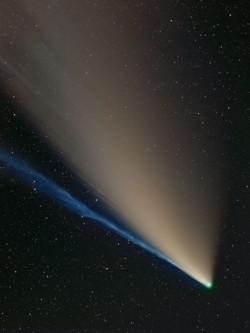Glossarbegriffe: Koma (Komet)
Description: Wenn sich ein Komet der Sonne annähert, gast er aus: Das bedeutet, dass ein Teil der Stoffe, die im eisigen Kern des Kometen gebunden waren, als Gas freigesetzt werden. Dieses Gas besteht größtenteils aus Wasser, enthält aber auch Kohlenmonoxid, Kohlendioxid, Ammoniak, Methan und Methanol sowie Staubteilchen. Es umgibt den Kern des Kometen wie eine diffuse, kugelförmige Wolke, die als Koma des Kometen bezeichnet wird. Je näher der Komet der Sonne kommt, desto mehr Moleküle werden durch die ultravioletten Photonen der Sonne aufgespalten. Dadurch wird die Koma aufgeheizt und ihre äußeren Bereiche dehnen sich aus. Schließlich werden die äußeren Regionen ionisiert und bilden den Ionenschweif des Kometen.
Zugehörige Glossarbegriffe:
See this term in other languages
Term and definition status: The original definition of this term in English have been approved by a research astronomer and a teacher The translation of this term and its definition is still awaiting approval
The OAE Multilingual Glossary is a project of the IAU Office of Astronomy for Education (OAE) in collaboration with the IAU Office of Astronomy Outreach (OAO). The terms and definitions were chosen, written and reviewed by a collective effort from the OAE, the OAE Centers and Nodes, the OAE National Astronomy Education Coordinators (NAECs) and other volunteers. You can find a full list of credits here. All glossary terms and their definitions are released under a Creative Commons CC BY-4.0 license and should be credited to "IAU OAE".
If you notice a factual or translation error in this glossary term or definition then please get in touch.
Zugehörige Medien
Comet C/2020F3 (Neowise) with separate dust and ion gas tails and a green glowing coma, by Dietmar Gutermuth, Germany
Bildnachweis: Dietmar Gutermuth/IAU OAE
License: CC-BY-4.0 Creative Commons Namensnennung 4.0 International (CC BY 4.0) icons









